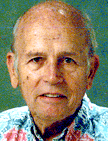


THERE it is on the wall: A blank outline map of the world. The continents and political boundaries are outlined -- but nothing is labeled. Can you identify the continents? How many countries can you name? How many countries do you know anything about? How Hawaii learns
about the worldThis gives at least a rough clue to the extent of our international education.
Specifically, what about the 10,000 Hawaii high school seniors who parade across stages in caps and gowns each year to get diplomas?
The rough information I gather is that:
Most of the 10,000 would not do very well with the map. Many would be just plain lousy.
But those who really want to learn about the world can. The opportunities are there in most of our schools. Often, however, they may be in elective rather than required courses in world history, global studies and geography, sometimes adjunct learning to required language study.
With all schools now wired to the Internet, ambitious students can dig out a lot for themselves.
Our business and government leaders tend to know much less globally than Asian and European counterparts. They may hesitate over global ventures for fear of showing their ignorance.
In 1988 Governor Waihee's Congress on Hawaii's International Role recommended we all try to improve our knowledge of the world. But school curriculums are full. Interest often is low. We haven't done too well.
Praise be, though, for the organizations that are helping.
Wo International Center at Punahou School reaches out in one way or another to most of Punahou's K-12 students. It has a high-tech auditorium that can connect worldwide. It arranges international student exchanges with Japan, China and other countries. These include some non-Punahou students. Others come to the campus for international summer sessions.
PAAC -- the Pacific and Asian Affairs Council. Largely privately funded, it has chapters in five private and 16 public schools with one of its biggest, 75 members, at Waianae. Its goal, carried also into community college programs, speaker programs for the general public and other activities, is to promote greater awareness and understanding of foreign affairs issues.
CTAPS -- the Consortium for Teaching Asia and the Pacific in the Schools. Based at the East-West Center, it conducts annual two-week summer institutes for teachers from the U.S. and the Asia-Pacific region. In 11 years about 40 percent of Hawaii teachers have participated.
THE Pacific Basin Consortium -- headquartered here and administered by the Hawaii Association of Independent Schools, it links 185 K-12 educational institutions in 20 Asia-Pacific region countries for student and teacher exchanges, bi-annual conferences and regional seminars.
Last year I took part in a meeting at a Buddhist temple in a bucolic rural setting remote from urban hubbub. A temple member had prepared his talk on funeral practices worldwide by striking up Internet conversations with new friends as far away as Scotland and Japan. It was fascinating.
He couldn't have done it without understanding that blank outline map of the world far, far better than most of our high school graduates.
A.A. Smyser is the contributing editor
and former editor of the the Star-Bulletin
His column runs Tuesday and Thursday.